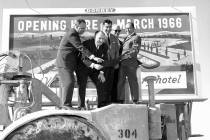Government funding of program that helps frail Medicare patients set to end
Twenty-two years ago during the Reagan administration, federal officials had a bright idea. What about helping frail Medicare patients remain at home longer by providing things like transportation to medical appointments, home health care, and other nonmedical services designed to keep patients out of nursing homes and hospitals.
It seemed sensible and compassionate and might even save money, so four pilot programs were started in 1985. Originally funded for three years, the program was extended repeatedly. Ten years ago, Sierra Health Services became the only publicly traded company to become part of the so-called Social Health Maintenance Organization pilot program, offering “extended care benefits” under Senior Dimensions.
On Jan. 1, Social HMO benefits end. And about 2,000 Nevadans who have come to rely on these nonmedical benefits may start screaming in frustration at Sierra, when the culprit is the federal government.
No, it’s not because of Sierra’s pending merger with United Health Group; it’s because the federal government isn’t funding the experiment anymore. Three years ago, the Bush administration decided the Social HMO program would be phased out. Essentially, it costs too much, according to two studies, studies Sierra challenged.
What the federal government giveth, it can taketh away.
In October, Sierra began telling roughly 2,000 Nevadans that “extended care benefits” will no longer be offered in 2008. The most popular benefits were transportation to medical appointments or health-related activities, adult day care, and respite care for caregivers, but there were a dozen benefits in all, including home-delivered meals and in-home physical therapy services. The cost to those on the program was minimal. A one-way trip to the doctor was $5, and even that might be waived.
If you are one of the 50,000 members of Senior Dimensions, don’t panic. You may still have similar benefits under other names such as the Member Value Services, a program that offers nonmedical services at a discount. It was designed to bridge the gap for those who no longer have extended care benefits.
Since the Social HMO program targeted the frailest Medicare patients, there’s already concern, particularly about the loss of the transportation benefit, explained Sierra spokesman Peter O’Neill. Sierra is trying to figure out a way to preserve that benefit, but he said it hasn’t been resolved yet. The 2008 benefits letter just says transportation is no longer available.
Those who relied on this transportation using Medi-Cab are being advised of options such as the CAT Paratransit services, Logisticare and Senior Lifeline. The frailest ones and wheelchair-users who constantly go to medical appointments are likely to be upset about the expense and convenience if Medi-Cab is no longer available.
O’Neill said the company is disappointed the federal government will no longer fund these benefits. “We would have thought they would have expanded it,” he said, “The people who took advantage of this were very, very ill.”
Mathematica Policy Research, which did one of the studies that Sierra challenged, said costs for the Social HMO plans are 15 to 27 percent higher than they would have been had the plans been paid under the same formula as a traditional Medicare HMO. Mathematica recommended that the Social HMO plans be phased into Medicare Advantage programs.
Walter Leutz of Brandeis University also studied the pilot programs and concluded they worked. “I don’t think it’s a wise move to phase it out. It’s unfortunate.” But he was never able to convince federal officials. The decision is part of the Bush administration’s emphasis on limiting spending on Medicare and cutting back on entitlements, he said. “Give lip service to help seniors, but cut services.”
He has studied the programs nationwide and said Sierra offered “an excellent program.”
But with dueling experts, the Centers for Medicare & Medicaid Services decided the program was too costly. David Sayen, associate regional administrator for Medicare Health Plans, said, “We can’t afford it as a social policy.”
Leutz said the studies the government relied on looked at costs and customer satisfaction, but never looked at whether Social HMOs kept more people out of nursing homes and hospitals.
Guess nobody can calculate a cost-benefit ratio of staying in your own home when you’re terribly ill and need a little extra help, like a ride to the doctor when you can’t drive.
Jane Ann Morrison’s column appears Monday, Thursday and Saturday. E-mail her at Jane@reviewjournal.com or call (702) 383-0275.
JANE ANN MORRISONMORE COLUMNS











